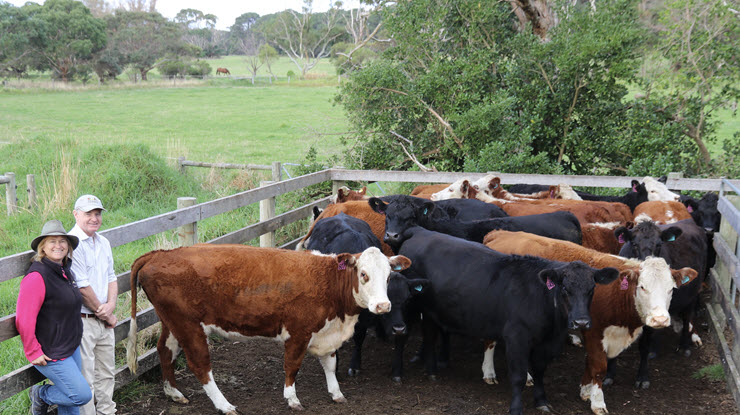Animal welfare: the key to high quality meat

Caption: Gippsland lamb and beef producers, Jenny and Paul O’Sullivan.
For Gippsland lamb and beef producers Jenny and Paul O’Sullivan, managing an environment where livestock are well fed, watered and stress-free is a primary focus of their production system and the key to producing high quality lamb and beef.
The O’Sullivans run 2,300 ewes and 400 cows across 640ha near Walkerville in Victoria’s Gippsland region. They supply lamb to Coles and sell pasture-fed beef into Coles, grass finishers and Gippsland Natural, which supplies beef to butcher shops and restaurants across Melbourne and Foster.
For both their lamb and beef products, a long-term commitment to the Meat Standards Australia (MSA) principles has led them to a management system that focuses on breeding, producing and selling happy, stress-free animals.
Focusing on animal welfare
“Animal welfare is the first thing we think of every single day,” Jenny said.
“In the early days with MSA, when we had animals that wouldn’t grade, we would trace them back and nearly always that animal had experienced some stress or a negative event. So, it didn’t take long to connect the dots between welfare and meat quality.
“For us to produce quality meat, we need to create and manage a system where the animals are comfortable. This means clean food and water, but also disease management and mitigating other negative forces like pests and predation.”
In a typically high rainfall region like Gippsland, worm management in sheep and young cattle herds is a key focus for the O’Sullivans, and industry research and development in this area has been hugely beneficial to pest control.
“MLA particularly has invested hugely in animal health and disease research. Worm burden in our region can have an enormous impact on young stock, so setting up a system that is scientifically proven and safe has been important,” Jenny said.
“We follow industry best practice, and as a result have created a very healthy environment where our animals can thrive and produce high quality beef and lamb for the consumer.”
Safe and ethically-produced meat
The O’Sullivans have travelled extensively throughout China, India and more recently Japan, observing consumer demands in the meat markets. A clear conclusion they drew from this travel was that Australian meat is highly sought after, because of the safe system in which it’s produced.
For the O’Sullivans, butchers play a critical role in communicating this story of safe, ethical meat production with domestic consumers.
“Butchers are so integral to our ability to communicate with the end user,” Jenny said.
“They’re the interface between the producer and consumer, and there’s a real opportunity to grow that communication channel and better engage with butchers, showing them firsthand the way we produce beef and lamb.”


